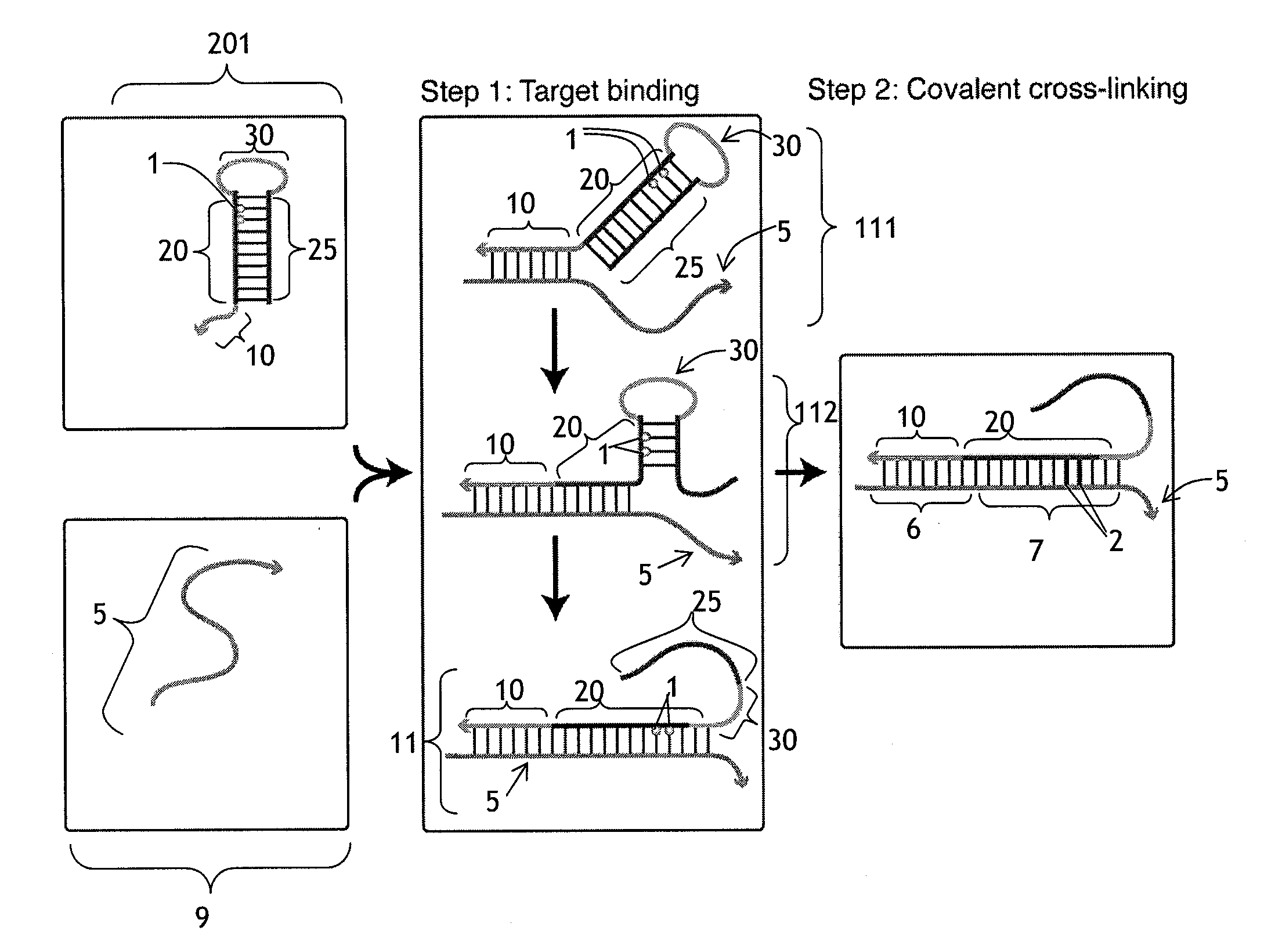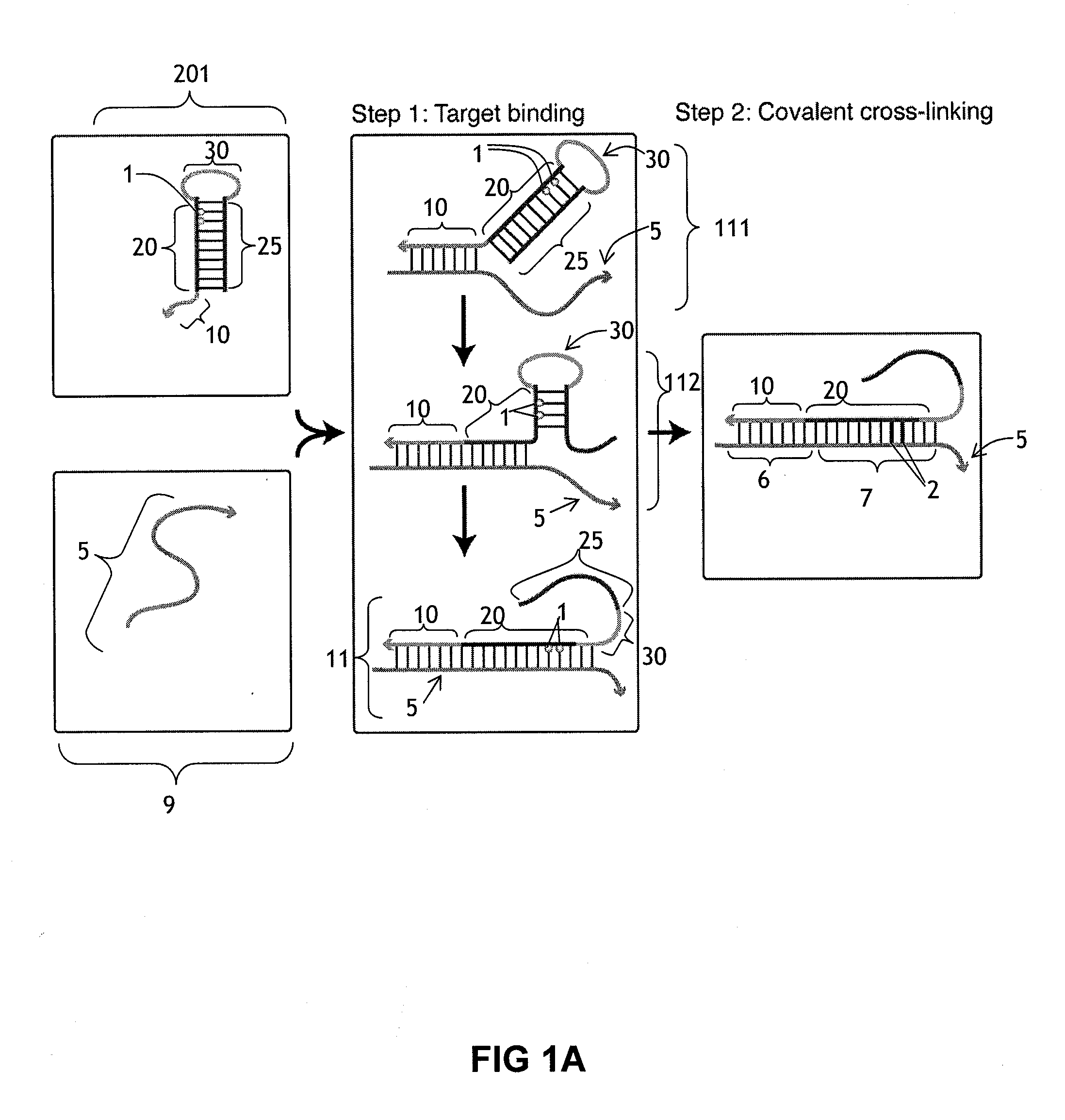Triggered covalent probes for imaging and silencing genetic expression
a covalent probe and gene expression technology, applied in the field of covalent crosslinking of nucleic acid probes, can solve the problems of relying on base pairing to provide both sequence specificity and binding affinity, and both techniques are powerful and widely used. , to achieve the effect of reducing or eliminating reducing the expression of a target gen
- Summary
- Abstract
- Description
- Claims
- Application Information
AI Technical Summary
Benefits of technology
Problems solved by technology
Method used
Image
Examples
example 1
Nucleic Acid Cross-Linking
[0188]This example illustrates the use of a cross-linking probe to attach a cross-linker to target nucleic acid, such as an mRNA.
[0189]One first obtains a cross-linking probe that includes an initiator region, a probe region that hybridizes to the desired target nucleic acid, a blocking region that obstructs the cross-linker when bound to the probe region, and a light activatable cross-linker. One then adds the cross-linking probe to the cell or tissue that is believed to include the target nucleic acid and allow the cross-linking probe to hybridize to the target. One then activates the cross-linker by irradiating the cell or tissue. Following this, the cross-linker will cross-link to the target nucleic acid, resulting in a cross-linked target.
example 2
[0190]This example illustrates a use of a cross-linker probe in an in situ hybridization. One performs the steps outlined in Example 1, except that the cross-linking probe also initially includes a detectable marker region (with one or more detectable markers) that is attached to the blocking region.
[0191]Following irradiation, one then washes the tissue or cell using an ultrastringent wash containing denaturing chemicals such as formamide and / or performing the wash at elevated temperatures. Following this, one then images the remaining detectable markers in the cell or tissue in order to identify whether or not, where, and how much of the target nucleic acid is present.
example 3
mRNA In Situ Hybridization Using a Hairpin Amplifier Molecule
[0192]This example illustrates a use of a cross-linker probe in an in situ hybridization. One performs the steps outlined in Example 2, except that the cross-linking probe also initially includes a pairing region that is attached to the blocking region.
[0193]Following the irradiation, one then washes the tissue or cell via an ultrastringent wash protocol to remove a significant portion of the unbound cross-linking probe. Following this, one then adds the amplifier molecule, which includes a detectable marker region (with decteable markers) and a complementary pairing region that will bind to the pairing region on the cross-linking probe. The amplifer molecule can have the general structure depicted in FIG. 4, and the amplifier molecule can include at least one photoactivatable cross-linker in the complementary pairing region. Following this, one can then irradiate the cell or tissue a second time to cross-link the cross-li...
PUM
| Property | Measurement | Unit |
|---|---|---|
| Nucleic acid sequence | aaaaa | aaaaa |
| Light | aaaaa | aaaaa |
Abstract
Description
Claims
Application Information
 Login to View More
Login to View More - R&D
- Intellectual Property
- Life Sciences
- Materials
- Tech Scout
- Unparalleled Data Quality
- Higher Quality Content
- 60% Fewer Hallucinations
Browse by: Latest US Patents, China's latest patents, Technical Efficacy Thesaurus, Application Domain, Technology Topic, Popular Technical Reports.
© 2025 PatSnap. All rights reserved.Legal|Privacy policy|Modern Slavery Act Transparency Statement|Sitemap|About US| Contact US: help@patsnap.com



